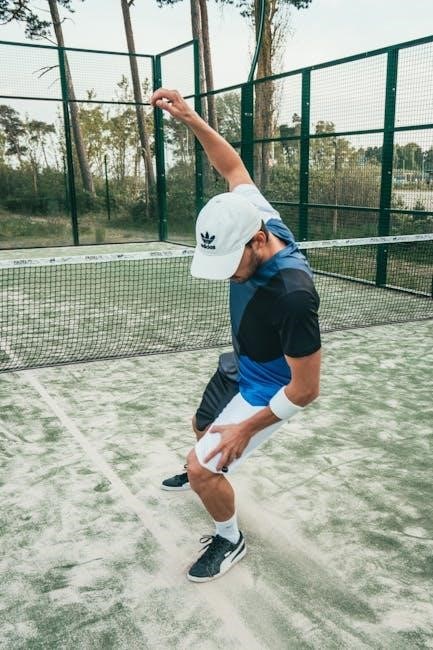Welcome to our guide on tennis workout plans! Discover how structured training can enhance your game with periodized approaches, covering strength, endurance, and agility. Explore PDF resources and expert strategies to optimize your tennis fitness journey.
What is a Tennis Workout Plan?
A tennis workout plan is a structured program designed to improve a player’s physical and technical abilities. It typically includes periodized training phases such as general preparation, strength, movement, and endurance. These plans are often provided in PDF format for easy access and organization. A well-designed plan focuses on key components like warm-ups, strength and core exercises, power development, foot speed drills, and flexibility routines. It also incorporates tennis-specific movement patterns and recovery strategies like yoga. The goal is to enhance endurance, speed, agility, and overall performance on the court. By following a structured workout plan, players can address specific aspects of their game, ensuring balanced development and peak conditioning for competitions. PDF plans are particularly popular for their clarity and portability, making them ideal for both home and gym training environments.
Why Use a Tennis Workout Plan in PDF Format?
Using a tennis workout plan in PDF format offers numerous advantages for players and coaches. PDFs are easily accessible and can be viewed on any device, making them ideal for on-the-go training. They provide a clear and organized structure, allowing users to follow routines without confusion. PDF plans often include detailed descriptions, diagrams, and progress tracking features, ensuring comprehensive guidance. Additionally, PDFs are sharable and printable, facilitating collaboration between players and coaches. Many free and paid PDF resources are available online, catering to different skill levels and goals. The portability and readability of PDFs make them a practical choice for tennis training, helping players stay focused and motivated during their fitness journey. This format ensures that workout plans are both user-friendly and effective, maximizing training efficiency and results.
Benefits of Periodized Training for Tennis
Periodized training is a highly effective approach for tennis players, offering structured and phased development. By dividing the training into specific cycles, players can focus on building endurance, strength, and movement skills sequentially. This method prevents overtraining and ensures balanced progress. Each phase targets different aspects of tennis performance, such as power, speed, and agility, allowing for peak conditioning during critical moments like competitions. The organized nature of periodized plans keeps players motivated and ensures consistent improvement. Over time, this systematic approach enhances overall athleticism and readiness for the demands of the sport, making it a cornerstone of successful tennis training programs.

Key Components of a Tennis Workout Plan
A well-structured tennis workout plan incorporates essential elements like strength, endurance, agility, and flexibility to enhance overall performance and prevent injuries, ensuring comprehensive athletic development.
Warm-Up and Mobilization Exercises
A proper warm-up is essential to prepare the body for intense tennis training, reducing injury risk and improving performance. Dynamic stretching, such as leg swings and arm circles, increases blood flow and flexibility. Mobilization exercises target key joints like shoulders, hips, and knees to enhance range of motion. Light cardio, like jogging or jumping rope, elevates heart rate and activates muscles. These exercises should last 15-20 minutes, progressing from general movements to tennis-specific actions. A well-structured warm-up ensures athletes are ready for the demands of the sport, preventing stiffness and improving reaction time. Consistency in this routine is crucial for long-term athletic development and peak performance on the court.
Strength and Core Training
Strength and core training are vital for building stability, power, and endurance in tennis. Exercises like planks, Russian twists, and leg raises target the core muscles, improving balance and rotational power. Compound movements such as squats, deadlifts, and bench presses enhance overall strength and muscle mass. These exercises help generate force for shots and sprints; Functional strength training, such as medicine ball throws and cable rotations, mimics tennis movements, enhancing performance. Incorporating resistance bands and weights can add variety and intensity. Consistency in this training improves serve power, groundstroke consistency, and overall athleticism. A strong core and muscular foundation are essential for dominating on the court and reducing injury risks. Proper form and progression are key to maximizing results.
Power and Speed Development
Power and speed development are crucial for explosive movements on the tennis court, enabling quick sprints, sharp changes of direction, and powerful shots. Plyometric exercises like box jumps and burpees improve muscular explosiveness. Sprint drills, such as short bursts of 10-20 meters, enhance acceleration and deceleration. Agility ladder workouts and cone drills refine foot speed and coordination. Resistance band training and medicine ball throws also contribute to generating rapid force. These exercises enhance reaction time and overall court performance. Proper form and progression are essential to avoid injury. Incorporating these into a tennis workout plan PDF ensures players can develop the speed and power needed to outperform opponents. Consistency and variety in training yield the best results.
Foot Speed and Coordination Drills
Foot speed and coordination drills are essential for enhancing agility and quick movements on the tennis court. Agility ladder drills, such as lateral shuffles and high knees, improve footwork precision. Cone drills, like zigzag runs and figure-eight patterns, boost directional changes and balance. Shuttle runs between markers develop acceleration and deceleration skills. Carioca drills and step-ups further refine coordination and reaction time. These exercises can be tailored to different skill levels and incorporated into a tennis workout plan PDF for structured practice. Consistent training improves court coverage, enabling players to reach shots more effectively. Proper technique and gradual progression are key to maximizing benefits and preventing injury.
Tennis-Specific Movement Patterns
Tennis-specific movement patterns focus on replicating the dynamic actions players perform during matches, such as shuffling, turning, and accelerating. Drills like the split step, approach shots, and lateral movements are emphasized to improve court coverage and reaction time. These exercises simulate match scenarios, helping players develop muscle memory for precise footwork. Incorporating these patterns into a tennis workout plan PDF ensures players can transition smoothly between strokes and maintain balance during intense rallies. By practicing these movements consistently, players enhance their ability to anticipate shots and position themselves effectively, leading to better overall performance and reduced fatigue during long matches.
Flexibility and Stretching Routines
Flexibility and stretching routines are essential for maintaining range of motion, preventing injuries, and enhancing overall performance in tennis. A well-structured tennis workout plan PDF includes dynamic stretches like arm circles, leg swings, and torso twists to prepare muscles for activity. Static stretches, such as hamstring, quadriceps, and chest stretches, are incorporated post-workout to improve flexibility and reduce muscle tightness. These routines target areas critical for tennis movements, such as the shoulders, hips, and lower back. Consistent stretching helps players maintain proper form during strokes and quick changes of direction. Over time, increased flexibility can lead to more powerful serves and groundstrokes, making it a cornerstone of any effective training program.
Yoga for Recovery and Flexibility
Yoga is a powerful tool for recovery and flexibility in a tennis workout plan. It helps improve circulation, reduce muscle soreness, and enhance joint mobility, which is crucial for tennis movements. Specific poses like “Child’s Pose” and “Downward Dog” target areas like the lower back and hamstrings, common tight spots for players. Yoga also promotes relaxation and mental clarity, aiding in post-match recovery. Incorporating yoga into a tennis workout plan PDF ensures players maintain flexibility and reduce injury risk. Many plans include yoga sequences tailored to tennis, focusing on balance, core stability, and breath control. Regular practice enhances overall performance and supports long-term durability on the court.

Creating a Periodized Tennis Workout Plan
A periodized plan divides training into phases, each focusing on specific goals like strength, endurance, or competition readiness. This structured approach ensures peak performance and reduces injury risk.
General Preparation Phase
The General Preparation Phase is the foundation of a periodized tennis workout plan, typically lasting 4-6 weeks. It focuses on building overall fitness, endurance, and strength. During this phase, players engage in low-to-moderate intensity exercises to improve cardiovascular health, muscular endurance, and flexibility. Workouts include aerobic activities, light strength training, and mobility drills to enhance movement efficiency. This phase also introduces basic tennis-specific movements, such as footwork patterns and stroke mechanics, to prepare the body for more intense training. The goal is to create a solid base for future phases, ensuring players can handle the demands of competitive play while reducing the risk of injury.
Strength and Power Phase
The Strength and Power Phase focuses on building muscular strength, explosive power, and endurance to enhance tennis performance. This phase typically lasts 4-6 weeks and involves resistance training, plyometrics, and high-intensity interval exercises. Players engage in weightlifting, medicine ball drills, and power-focused movements to improve serve power, groundstroke efficiency, and acceleration. The workouts are designed to target key muscle groups, such as the legs, core, and shoulders, which are critical for generating power in tennis. By incorporating dynamic exercises, players develop the ability to explode into sprints and hit powerful shots, giving them a competitive edge on the court. This phase bridges the gap between general preparation and sport-specific demands.
Endurance and Movement Phase
The Endurance and Movement Phase is designed to enhance cardiovascular fitness, muscular endurance, and movement efficiency for long-lasting performance on the court. This phase typically lasts 4-6 weeks and focuses on building stamina through high-intensity interval training, circuit workouts, and prolonged rallies. Players perform exercises like suicide drills, ladder drills, and medicine ball throws to improve speed and agility. The phase also incorporates aerobic exercises to boost endurance, ensuring players can sustain energy levels during extended matches. Proper nutrition and recovery strategies are emphasized to support the physical demands of this phase, helping players maintain consistent performance over time. This phase is vital for preparing athletes for the mental and physical challenges of competitive play.

Competition Phase
The Competition Phase focuses on refining skills, strategies, and mental toughness for actual match scenarios. This phase emphasizes maintaining peak physical fitness while avoiding overtraining. Players engage in simulated match play, focusing on tactical execution and decision-making. Drills are designed to mimic game situations, improving reaction time and shot accuracy under pressure. Strength and conditioning exercises are scaled back to prioritize recovery, ensuring players are fresh for competitions. Mental preparation techniques, such as visualization and stress management, are integrated to build confidence. The goal is to optimize performance, adaptability, and resilience, enabling players to compete at their best during tournaments and leagues. This phase is all about translating training into winning results.
Types of Workouts Included in the Plan
Tennis workout plans include a mix of on-court drills, strength training, flexibility exercises, and mental preparation. These workouts are tailored to enhance performance and endurance.
Home Workouts vs. Gym Workouts
Home workouts offer convenience and flexibility, allowing players to train without gym access. They often focus on bodyweight exercises, plyometrics, and dynamic stretching, which are ideal for improving strength and agility. Gym workouts, however, provide access to specialized equipment like weights, resistance bands, and machines, enabling targeted muscle development and power training. Gyms also offer a structured environment that can enhance motivation and discipline. Both options are effective, but the choice depends on personal preferences, available resources, and specific training goals. A well-rounded tennis workout plan may incorporate elements from both settings to maximize results and ensure comprehensive physical preparation.

On-Court vs. Off-Court Training
On-court training focuses on specific tennis skills, such as stroke production, footwork, and match strategy, directly enhancing performance during matches. It involves drills, practice sessions, and simulated game scenarios to refine technique and decision-making. Off-court training, however, targets physical conditioning, including strength, endurance, and flexibility, through exercises like weightlifting, cardio, and mobility workouts. Both are essential for a balanced tennis workout plan, as on-court drills improve technical abilities while off-court conditioning builds the physical attributes needed for peak performance. A well-structured plan combines these elements to ensure players are both skillful and physically prepared for competition.

Video and PDF Format Workouts
Video and PDF format workouts offer versatile and accessible training options for tennis players. Videos provide visual demonstrations of exercises and drills, ensuring proper form and technique. They are ideal for understanding complex movements and can be replayed as needed. PDF guides, on the other hand, provide structured plans that can be downloaded and referenced anytime, making them perfect for tracking progress and creating personalized routines. Together, these formats cater to different learning preferences and ensure comprehensive training. Videos enhance engagement, while PDFs offer portability and ease of use, making them invaluable tools for both on-court and off-court training in a tennis workout plan.
How to Find the Best Tennis Workout Plans
To find the best tennis workout plans, research reputable sources, and consider both free and paid options. Look for plans tailored to your skill level and goals.
Free Resources Available Online
Free tennis workout plans in PDF format are widely available online, offering a cost-effective way to improve your game. Websites like Tennis.com, ITF Tennis, and USTA provide downloadable guides tailored to various skill levels. Social media platforms such as Instagram and YouTube feature trainers sharing free workout plans and tutorials. Blogs and forums dedicated to tennis often publish comprehensive PDF guides covering strength, agility, and endurance training. These resources are ideal for players seeking to enhance their performance without investing in paid programs. They typically include exercises, drills, and sample routines that can be adapted to individual needs. Utilizing these free resources can be a great starting point for building a structured training regimen.
Paid Programs and Their Advantages

Paid tennis workout programs offer personalized and structured training regimens tailored to specific goals and skill levels. These programs are often designed by professional coaches and include detailed video demonstrations, nutrition advice, and recovery strategies. Unlike free resources, paid plans provide in-depth guidance, ensuring a comprehensive approach to improving performance. Many paid programs also offer community support through forums or direct access to coaches for feedback. Additionally, they are regularly updated with the latest training methods and research, making them a valuable investment for serious athletes. The structured and expert-led nature of paid programs can lead to faster progress and better results compared to generic free plans.
How to Choose the Right Plan for Your Needs
Choosing the right tennis workout plan requires assessing your current fitness level, tennis experience, and specific goals. Consider whether you aim to improve endurance, strength, or agility. Evaluate the format of the plan—PDFs are ideal for structured, printable guidance. Ensure the plan aligns with your available time and resources, such as access to a gym or court. Look for customizable options that allow adjustments based on progress or injuries. Additionally, seek plans endorsed by certified coaches or professionals, as they often provide expert-level insights. Reading reviews or testimonials from other players can also help you identify a plan that suits your needs effectively.
Sample Workout Plan for College Tennis Players
A sample tennis workout plan for college players includes strength training, agility drills, and on-court exercises tailored to enhance performance during matches and tournaments effectively.
Developing Power and Strength
A key component of a college tennis player’s workout plan is building power and strength to enhance performance on the court. This includes exercises like box jumps, burpees, and medicine ball throws to improve explosive power. Strength training focuses on compound movements such as squats, deadlifts, and bench presses to target major muscle groups. Core exercises like planks and Russian twists are also essential for stability and rotational power; Players should aim for 3-4 sets of 8-12 reps for strength exercises and 3-5 sets of 10-15 reps for power drills. Progression is important, so weights or reps should increase gradually to avoid plateaus and prevent overtraining.
Improving Speed and Agility
Enhancing speed and agility is crucial for college tennis players to excel on the court. Speed drills, such as short sprints and shuttle runs, improve acceleration and deceleration. Agility ladder exercises and cone drills help refine footwork and quick changes of direction. Plyometric exercises like jump squats and box jumps enhance explosive power. Off-court activities, such as resistance band training and box jumps, also contribute to faster movements. Players should incorporate these drills 2-3 times weekly, focusing on proper technique to maximize efficiency. Incorporating these exercises into a well-structured PDF workout plan ensures consistent progress and adaptability to the demands of competitive tennis matches.
Building Endurance for Long Matches
Building endurance is essential for college tennis players to sustain energy levels during prolonged matches. Cardiovascular exercises like distance running, cycling, and swimming are effective for improving stamina. On-court endurance drills, such as continuous rallying and baseline-to-baseline sprints, simulate match conditions. Incorporating high-intensity interval training (HIIT) enhances both aerobic and anaerobic capacity. Players should also focus on muscular endurance through core and leg strengthening exercises, as strong muscles help maintain consistent performance. Proper nutrition and hydration strategies are emphasized to fuel endurance. Training plans should include endurance sessions 3 times weekly, with gradual intensity increases. Dynamic stretching post-workout aids recovery, ensuring players remain prepared for demanding matches.

Additional Resources for Tennis Training
Additional resources for tennis training include detailed guides, webinars, and community forums offering expert advice, workout variations, and recovery techniques to complement your PDF plan.
Free Introductory Workouts in PDF
Free introductory workouts in PDF format are an excellent starting point for players new to structured training. These downloadable resources often include basic exercises, drills, and routines tailored to improve tennis-specific skills. Many websites, forums, and training platforms offer these PDFs, providing a cost-effective way to begin a workout regimen. They typically cover essential areas like strength, agility, and technique, with clear instructions and diagrams. These resources are ideal for self-guided training and can be printed for convenience. Additionally, they often include tips on nutrition, recovery, and mental preparation, making them a comprehensive tool for anyone looking to enhance their tennis performance without initial investment.
Video Tutorials for Proper Form
Video tutorials are an invaluable resource for mastering proper form and technique in tennis workouts. They provide visual guidance, allowing players to observe and mimic exercises accurately. Many websites and training platforms offer video content that complements PDF workout plans, ensuring that players can perform movements safely and effectively. These tutorials often feature slow-motion replays, close-ups, and expert commentary, making it easier to understand complex drills. Additionally, videos can be paused or replayed, enabling learners to focus on specific details. This combination of visual and instructional content helps players avoid injuries and maximize the effectiveness of their training routines, making video tutorials a essential tool for improvement.
Downloadable Practice and Match Frameworks
Downloadable practice and match frameworks provide structured templates for organizing training sessions and competitions. These frameworks often include detailed drills, strategies, and schedules tailored to specific skill levels and goals. Players can access these resources in PDF format, making it easy to print or share with coaches and teammates. Many frameworks cater to both individual and team practices, offering a comprehensive approach to improving technique, tactics, and mental preparation. They may also include space for notes and progress tracking, allowing players to adjust their training based on performance. By following these frameworks, athletes can ensure they cover all essential aspects of their game, leading to more effective and focused practice sessions.

Case Studies and Success Stories
Professional players and teams share inspiring journeys, showcasing how structured tennis workout plans in PDF formats boosted their performance, strength, and agility, leading to tournament successes.
Professional Tennis Players’ Routines
Professional tennis players rely on structured workout plans in PDF formats to optimize their training. These plans detail daily routines, including strength exercises, on-court drills, and recovery sessions. Top players like Roger Federer and Serena Williams have credited their success to consistent, periodized training programs. Their routines often include dynamic warm-ups, core stability exercises, and sport-specific movements to enhance power and agility. The PDF format allows for easy access and organization, ensuring they stay on track during intense tournament schedules. By following these plans, professionals achieve peak physical condition, mental focus, and sustained performance throughout the season.
College Coaches’ Training Strategies
College coaches use tennis workout plans in PDF formats to structure comprehensive training programs for their teams. These strategies focus on building athleticism, technique, and mental toughness. Coaches often periodize training, dividing the season into phases to peak performance for key matches. They emphasize on-court drills for stroke production and footwork, alongside off-court strength and conditioning exercises. Mental preparation, such as visualization drills and pressure exercises, is also integrated. Coaches tailor plans to address individual player needs while fostering teamwork. The PDF format allows for easy distribution and tracking of progress. This holistic approach ensures players are well-rounded, competitive, and prepared for the demands of college tennis.
Tracking Progress and Adjusting the Plan
Regularly track workouts using logs and assessments. Adjust intensity, volume, or focus based on progress and feedback. This ensures continuous improvement and prevents plateaus, keeping players motivated.
Setting Goals and Measuring Improvement
Setting clear, measurable goals is vital for tracking progress in a tennis workout plan. Start by defining specific, achievable objectives, such as improving serve speed or increasing endurance. Use a PDF log to record workouts, weights, and performance metrics. Regularly assess progress through fitness tests, match performance, or strength measurements. Celebrate milestones to stay motivated and adjust goals as needed. Incorporate feedback from coaches or training partners to identify areas for improvement. Reflect on past performances to refine strategies and ensure alignment with long-term aspirations. By systematically measuring improvement, players can optimize their training and maintain a focused, results-driven approach to their tennis workout plan. This structured method ensures consistent growth and peak performance.
Adjusting the Plan Based on Performance

Adjusting a tennis workout plan based on performance ensures continuous improvement and keeps training aligned with goals. Regularly review progress, such as increased strength, speed, or endurance, to identify areas needing refinement. If a player excels in power but lacks flexibility, incorporate more stretching exercises. Conversely, if endurance is lagging, intensify cardio sessions. Coaches or trainers can provide insights to tailor the plan effectively. Adjustments should be data-driven, using metrics like serve speed or match performance. Fine-tuning the plan seasonally or quarterly helps maintain motivation and prevents plateaus. By adapting to performance feedback, players can optimize their training and achieve peak readiness for competitions. Consistent evaluation ensures the workout plan remains dynamic and effective, fostering long-term success in tennis.
